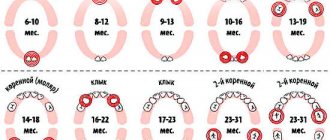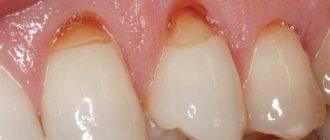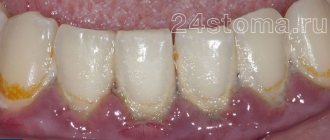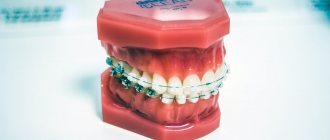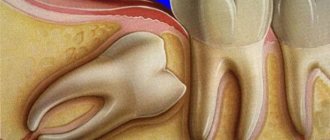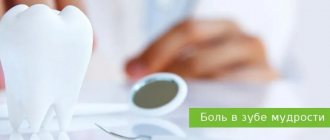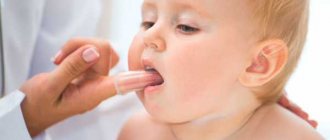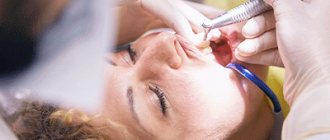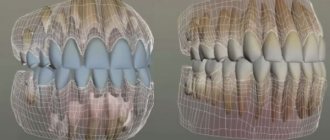The first reaction of parents who notice that their child is growing a second row of teeth is natural fear. In dentistry, it is generally accepted that there are two causes of pathology:
- abnormal growth of molars;
- polyodontia or supernumerary teeth.
Normally, permanent teeth replace baby teeth only after the latter fall out. The germ of the molar tooth stretches upward, thereby contributing to the destruction of the roots. With some features of jaw development, this does not happen, which is why the second row appears.
Reasons for the growth of the second dentition in a child
Double or “shark” teeth in children appear when the baby tooth and the rudiment of the molar are located at different points in the oral cavity. When a new set erupts, the baby tooth remains in place. A tooth grows above a tooth, which not only does not look aesthetically pleasing, but also interferes with the development of the rest of the row.
The most common reason why teeth do not change is improper breathing. A lot depends on how a child breathes. Breathing disorders lead to problems with bite, deterioration of posture and changes in facial shape.
A child’s jaw develops correctly only when he breathes correctly through his nose. The tongue in this position presses on the palate from the inside. A natural semicircular shape of the jaw is formed, in which there is enough space for all the molars. This is why it is so important to teach your child to breathe through his nose to prevent the growth of the second row of teeth.
Symptoms
During the period when a child’s primary incisors appear and they are replaced by root units, parents should regularly examine the baby’s oral cavity. If you are alarmed by any manifestations, you must make an appointment with a pediatric dentist.
| Symptomatic manifestations | |
| Name | Description |
| Painful sensations | They are most often experienced when pressing on the mucous membrane or while eating. The soft tissue around the incisor may become inflamed. |
| Swelling of the gums | Pathological processes - tissue reaction, which manifests itself in the form of swelling. |
| Physical weakness, fever (up to 38-39 degrees) | During the inflammatory process, the temperature often rises and weakness in the muscle tissue is felt. |
| The baby tooth is loose but does not fall out | The symptom indicates a lack of solid food or pathology in the development of the jaw system. |
| Excessive salivation | When the nasopharynx is swollen, the nose becomes clogged, and as a result of breathing through the mouth, the mucous membrane dries out. Excessive salivation is a protective function of the body, preventing the penetration of germs and infections through the oral cavity. |
| Development of rhinitis | This process develops against the background of swelling of the nasopharyngeal mucosa. |
| No interdental gaps | From about 4 years of age, children develop large gaps between their teeth. If such a sign is not observed, then, most likely, a narrowing of the rows is developing. This leads to the growth of a second row of teeth. |
Supernumerary teeth in children
The appearance of additional tooth buds is rare, occurring in only 2% of cases. The anomaly is associated with a disorder of embryonic development. A tooth that appears above a child's tooth is usually removed. But this does not always happen: if the tooth does not disturb the shape and aesthetics of the dentition, the dentist can leave it.
Sometimes supernumerary teeth are located outside the dental arch. The appearance of a tooth on the palate of a child is rare, however, this is no exception. There is no need to be afraid of this: it does not affect your health in any way. The Natadent clinic has a pediatric orthodontist who will help solve this problem quickly and painlessly.
When permanent teeth do not appear for a long time
The absence of permanent teeth for too long can be due to several reasons: these are the genetic characteristics of the body, their immaturity, and the destruction of tooth germs by some kind of infection.
Only a dentist can determine the true cause. At the A-Medic Network of Medical Clinics clinic, they will take a picture of the jaw, which will show how the child’s permanent teeth are formed. Sometimes they can grow inside the gums. If nothing is visible on the image, the doctor may suggest solving the problem by installing dentures.
What to do if the child’s teeth grow in the second row?
When a doctor sees a tooth above a patient’s tooth, he immediately understands what’s wrong. First, the orthodontist removes the baby tooth. After this, the permanent tooth will move into place on its own under the action of the tongue muscle, if there is enough space. But what to do if a child has a lack of space for molars?
The primary task of the dentist and parents will be to restore normal breathing. At this stage, it is necessary to “retrain” the muscles of the mouth to work differently. This is where trainers or mouthguards come to the aid of specialists.
Orthodontic appliances solve several important problems:
- train the muscles of the oral cavity, stimulating their natural development;
- correct the direction of development of the child’s jaws;
- correct the position of the tongue in the oral cavity;
- teach the child to breathe through the nose;
- get rid of bad habits.
Wearing trainers is most often considered as a preparatory stage. After this, more serious orthodontic treatment begins with the use of braces. However, here the first step is the most important, since the effectiveness of further work depends on it.
Crooked teeth
If permanent teeth begin to grow unevenly, you need to come for a consultation with an orthodontist at the A-Medic Network of Medical Clinics as soon as possible. The sooner such a decision is made, the easier it will be for the dentist to correct their growth. An incorrect bite is not only inconvenient, it can lead to the development of a number of diseases, for example, caries, stomach diseases, and cause childhood and teenage complexes and psychological problems.
The easiest way to straighten your jaw is to wear braces. It is very important for parents, together with the attending physician, to explain to the child that temporary inconveniences when using braces are justified and will bring invaluable benefits in the future. You need to take good care of it, because it will stay in your mouth for at least six months. This design will work most effectively during adolescence. Small children can more easily tolerate plates or trainers, which look something like boxing mouthguards, rather than braces. Children's enamel is quite delicate, so trainers that do not damage it will be the best way to correct a child's malocclusion.
How to understand that a child is at risk of growing teeth in two rows?
Attentive parents should monitor the process of teeth growth and loss. The change of dentition begins at 6-8 years: the first to fall out are the central and lateral incisors. At 9-11 years old, the lower canines change. By the age of 10-12, the upper canines and small molars grow. The formation of the bite ends at the age of 13-14 years.
A child’s tooth grows above the tooth when the baby tooth does not leave its place in due time. In this case, parents should definitely consult a doctor. The earlier the pathology is detected, the easier it is to correct the child’s second dentition.
You don’t have to wait for your baby teeth to suddenly fall out on their own! If you notice that your child’s molars are cutting in, but his baby teeth aren’t even loose yet, take him to the dentist. With “shark” teeth, not only the appearance, but also the shape of the jaw is disrupted.
Consequences
Even one molar that grows behind a baby tooth causes a lot of trouble. Ignoring the problem and lack of treatment leads to the following consequences:
- the child’s diction is impaired;
- the process of chewing food occurs poorly, the food is not crushed to the desired consistency;
- additional load on other teeth provokes displacement of healthy units, this provokes intense curvature of the bite;
- diastemas and trema (gaps) form between the chewing teeth and the front permanent teeth;
- the roots of healthy incisors and molars become bent.
Mouthguard as a preventive measure for the second dentition
In dental practice, mouth guards are worn by children over four years of age. At this age, the child is already consciously approaching wearing a trainer and can wear it for a long time. The device is made according to individual casts, taking into account the characteristics of jaw development. The material from which the mouthguard is made is soft and does not injure the mucous membrane.
From the age of two, children can wear removable plates to correct bad habits. If a child often sucks a pacifier or fingers, his bite does not develop properly. These children are more likely to have teeth growing in two rows. A soft plate will help avoid this.
In our clinic, parents trust doctors with their most valuable asset – their children. You can rely on our specialists in any situation. To confirm these words, we publish reviews from our grateful clients.
Natadent specialists know how to win over the youngest patients. Most guys leave the dentist's office without the same fears. True professionals in their field not only master their tools flawlessly, but also make every trip to them as comfortable as possible.
Possible complications
Chronic osteomyelitis of the lower jaw
As a result of incorrect or untimely treatment of hyperdontia, the situation may become more complicated. The most common options are: malocclusion and the development of speech defects.
Ignoring the problem of the growth of double dentition leads to chronic osteomyelitis of the jaw against the background of the inflammatory process of dentin, as well as to the death of the rudiments of molars and their abnormal growth.
In addition, the child receives psychological trauma caused by the aesthetic factor and the negative attitude of others.
Main differences from similar pathologies
Differentiating a split tooth from other outwardly similar anomalies is in some cases a difficult task , which can only be solved with the help of radiography, and even then not always.
Combined anomaly in the form of a styloid lateral incisor
The awl-shaped lateral incisor has a low, conical crown that converges at a blunt point.
The reason for its appearance is most often heredity, less often - endocrine disorders, delay in the loss of milk ducts. Often, subulate incisors are combined with other anomalies - agenesis (hypodontia), transposition of the canines, etc.
The difference between a subulate incisor and a forked one is the normal number of teeth in a row. Schizodontia increases it by one unit.
It is recommended to treat a permanent subwl incisor as it impairs esthetics and reduces the efficiency of chewing food. Usually it is restored with a composite or covered with an artificial crown.
Why short teeth can lead to big problems.
Come here to understand how to deal with speckled teeth.
At this address https://orto-info.ru/zubocheliustnye-anomalii/zubov/prorezyivaniya/chem-otlichaetsya-impaktnyiy.html we’ll talk about impact teeth.
Supernumerary microdont incisor
Like split teeth, supernumeraries increase the number of units compared to the norm. It can only be accurately differentiated from a split tooth using radiography. Like the subulate incisor, it grows from its own follicle.
A supernumerary microdont incisor has reduced dimensions compared to normal ones. Its treatment depends on the clinical picture. If it causes discomfort, interferes with speech, chewing and aesthetics, it is removed.
Gemination (doubling)
An anomaly close, but not identical to bifurcation. Schizodontia is characterized by the formation of 2 completely separated teeth identical to each other.
Gemination is only an attempt at separation, in which the units grown from one embryo are not completely separated from each other. In particular, they have separate crowns, but fused roots.
Or from the occlusal plane there is a deep depression in the middle of the crown. However, in terms of etiology, gemination and schizodentia are completely identical; teeth grow from the same follicle.
On the radiograph, the unit that has undergone gemination has one large pulp cavity and an enlarged root.
Guarantees
Our Center uses implants with a lifetime guarantee - Nobel Biocare. We provide guarantees:
- 2 years for treatment;
- 1 year for prosthetics;
- lifetime for implantology.
Warranty obligations apply provided that the patient follows the doctor’s recommendations, rules of care and regularly visits the dentist. The warranty program includes a complex: for an implant, surgery, bone reconstruction and prosthetics.
What is polyodontia?
Supernumerary teeth are extra units in the dentition. There can be 33,34,36 or even more than 100. Normally, the number of teeth in a child’s primary occlusion should not exceed 20, and in an adult – 32 units.
Most often, additional incisors or canines appear. It is much less common for a person to grow extra wisdom teeth, and they usually remain impacted.
Supernumerary teeth in an adult differ from the rest in size, development of the crown and root. They can also have a different shape, resembling, for example, a thorn or a drop.
If the extra units have not erupted, then polyodontia usually does not cause any unpleasant sensations. Therefore, we often learn about the existence of supernumerary teeth only during radiography.
Causes of jaw abnormalities
To date, doctors have not reached a unanimous opinion about the causes of such an anomaly as hyperdontia. There are different hypotheses about this:
- Atavism. Historians have proven that primitive people, due to the way of life they led, naturally had 36 tooth primordia. The results of studies of the remains of those times indicate that people had six incisors on the upper and lower jaws. Therefore, polyodontia is a kind of genetic anomaly that makes itself felt after thousands of years;
- Many doctors are inclined to the theory that one embryo splits into several in the womb, when, in fact, they begin to form. This theory also states that an anomaly can develop throughout pregnancy if it was quite severe, the woman suffered serious illnesses or led an unhealthy lifestyle (bad habits, drugs, alcohol and others);
To date, research continues to establish the true cause of hyperdontia. Based on these data, modern doctors are more inclined to the second version than to the first.
Doctor's advice - crowns can be placed immediately
For this purpose, a one-stage implantation method is used, when an implant is placed and covered with a crown on top, without waiting for its engraftment. The method is used when there is a sufficient amount of bone tissue. Used for dental units that do not actively participate in chewing. The crown is placed temporary, made of plastic or metal-plastic, and removed from the bite (lower in height) to eliminate active loads. After engraftment, it changes to permanent.
Levin Dmitry Valerievich
Chief physician, Ph.D.
Alternatives to implantation
- Dental bridge - structures in the form of welded crowns are placed in place of missing teeth. Along the edges they rest on supporting living teeth, the middle pendant teeth replace lost teeth. The method has disadvantages - grinding and depulping of supporting units, the process of bone atrophy continues, short service life in comparison with implants - up to 15 years.
- A removable denture is an artificial gum with plastic crowns. It is attached to adjacent teeth with hooks or to the gums using suction. Under such prostheses, bone atrophy progresses with greater force. In addition, it is uncomfortable for a person to chew, and long-term addiction occurs. Service life - up to 7 years.
When is bone augmentation needed?
For implantation to be carried out flawlessly, a sufficient amount of bone tissue is required. If teeth are missing for more than a year, then in 95% of cases bone grafting will be needed due to atrophy. Osteoplasty is needed so that the implant does not damage blood vessels, nerves, and recreates normal anatomy. The strength of root fixation also depends on it.
Our Center uses the following methods:
- Sinus lifting is a bone grafting procedure performed on the upper jaw in the area of the maxillary sinus. The mucous membrane is lifted, the vacated space is filled with bone chips. Often performed simultaneously with implantation.
- Guided bone regeneration - the gum is exfoliated, bone material is added, and covered with a membrane. Implants are installed at the same time if the bone deficiency is small. Recovery takes six months.
Implantation without bone grafting is possible when, along with implantation, the process of tissue growth begins. This technology is optimal; bone growth stimulators are fixed to the neck of the implant. The procedure is low-traumatic, but expensive. Its type - autotransplantation (transplantation of bone blocks from other parts of the human body) - is not used in the clinic, because the blocks can dissolve.
The sooner the tooth is restored, the less bone loss develops, so surgery to build it up may not be necessary.
When to hesitate to see a doctor
If a “shark” problem appears and the child complains of pain, the gums are inflamed, swollen, you need to immediately get dental care. Also warning symptoms are:
- bad breath;
- bleeding of the affected gums;
- separation of pus in the area of inflammation;
- severe discomfort while chewing food.
You should not wait a day if the child has a predisposition to malocclusion, for example, if he has previously undergone treatment for malocclusion or one of the parents wore braces. In all these situations, removal should be carried out as soon as possible. This measure will be a good prevention of possible complications.
Dear Doctor Orthodontist
The specialist will also examine the oral cavity and select an apparatus for correcting the dentition:
- trainer - silicone or polyurethane device, mouthguard. Wear it for an hour before bed. The materials are light and easy to clean. The device corrects bite and diction, and also creates additional rigidity. This will help the jaw to expand for new teeth;
- plate with expansion screw - a spacer made of soft plastic, with metal arches and a screw in the middle. It fits against the roof of your mouth and gums and provides pressure to your jaw and teeth. Indications: correction of jaw shape, teeth position, palate stretching;
- palatal clasps are metal arches that are secured with hooks on two or four teeth. Rings are placed on the teeth, to which hooks are attached. Also, plates with screws are considered a type of clasp. Such devices correct the shape of only the upper jaw. But with their help you can move your teeth forward or backward, fix them and even tilt them.
- And the most famous way to straighten teeth is braces. The structure is not removable thanks to the fixing glue-bond, which covers the teeth from the outside or inside. And an elastic arc made of steel or an alloy of nickel and titanium slowly but inevitably brings the “shark” smile into a Hollywood state.
The choice of correction method depends on the reason for the lack of space for teeth:
- physiological feature of tooth formation;
- insufficient jaw growth.
The age of the small patient is also taken into account. Braces can be installed from the age of 10, but they will work more effectively from the age of 12, when permanent teeth are actively growing. Up to 12 years old, plates and trainers are suitable. The second row of teeth is not a reason for frustration, but an opportunity to create a beautiful smile.
Reasons for formation
One of the reasons for the formation of twin teeth is heredity. Currently, more than 300 genes responsible for odontogenesis have been identified.
In addition to hereditary factors, poor nutrition and unsatisfactory health of the mother during pregnancy can lead to bifurcation: endocrine disorders, infectious and inflammatory processes, taking medications, injuries, ionizing radiation.
What is the difference between a persistent tooth and an impacted one?
In this publication, we will look at the reasons for the long-term absence of incisors.
Here https://orto-info.ru/zubocheliustnye-anomalii/zubov/kak-ispravit-vyisokoe-i-nizkoe-polozhenie-otdelnyih.html read useful information about the high and low position of individual teeth.
How is removal carried out?
If the abnormal tooth is single and it is not difficult to get to it using surgical instruments, then there will be no problems, and the tooth will be removed using a standard method. If there are several teeth, they are located in hard-to-reach places, have several roots, or have not fully erupted - in this case, removal is carried out as follows:
- The doctor administers an anesthetic so that the patient does not experience pain during the procedure.
- A small incision is made on the mucous membrane.
- If the roots of the tooth are deep, the doctor may make a small hole using a special bur to provide access to the root system of the tooth.
- The tooth and root are removed using forceps.
- Next, the area is disinfected using antiseptic agents.
- Stitches are applied.
- To avoid complications, antibiotics, anti-inflammatory drugs, etc. may be prescribed.
Please note that before surgery, an X-ray diagnosis is required. In this way, the doctor assesses the condition of the root system and other features. Only after the diagnosis is carried out is the issue of tooth extraction decided.
Is it possible to install implants immediately after removing 2 teeth?
This method is possible. Single-stage implantation is used, in which the implant is placed immediately into the hole after tooth extraction. But the following conditions must be met:
- the procedure is planned in advance to allow for diagnostics and assessment of the operation;
- removal was carried out atraumatically, without damaging the alveolar process;
- there should be no inflammation, cysts, granulomas, purulent processes;
- the volume of bone tissue is sufficient for the implant to be securely fixed.

